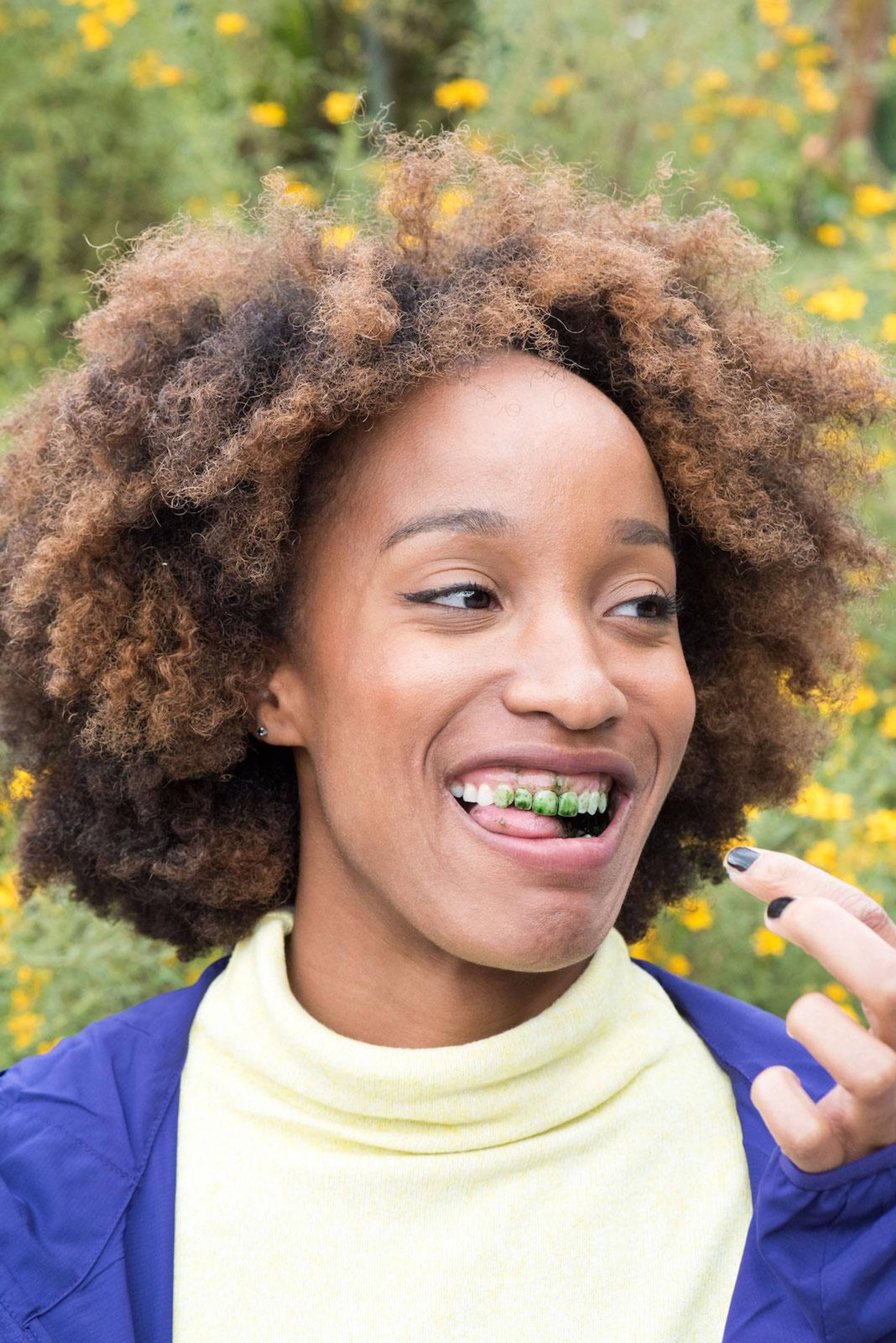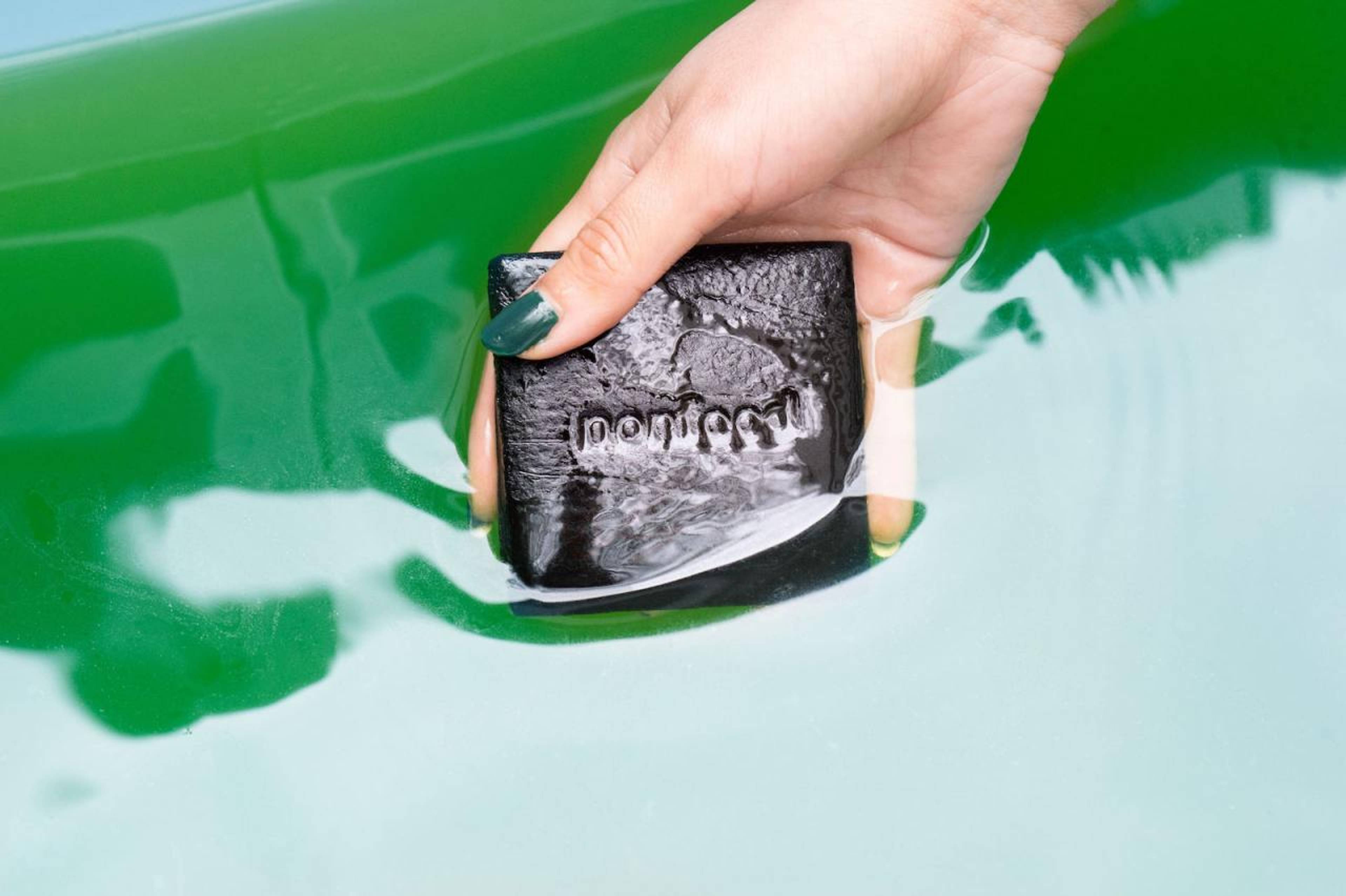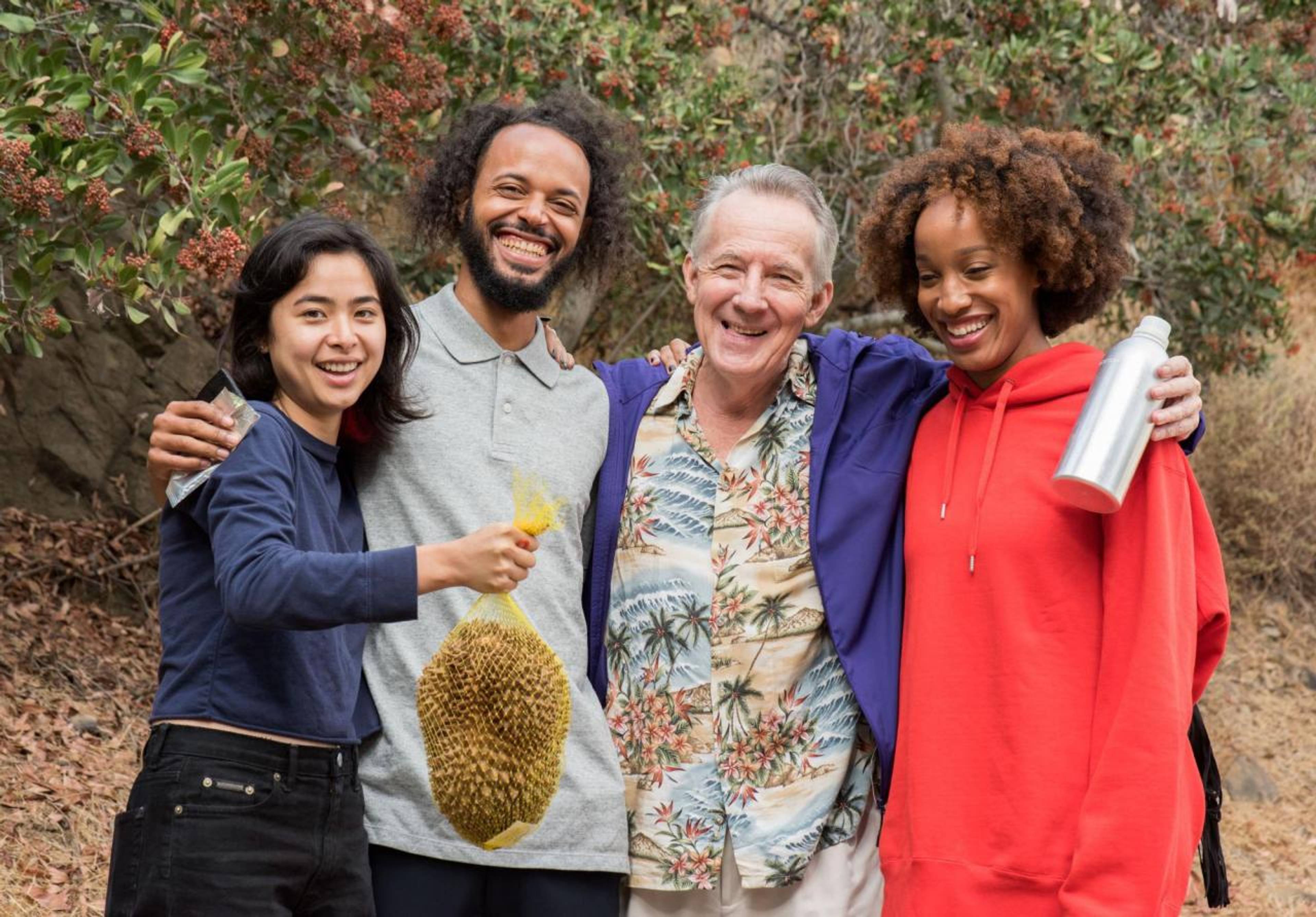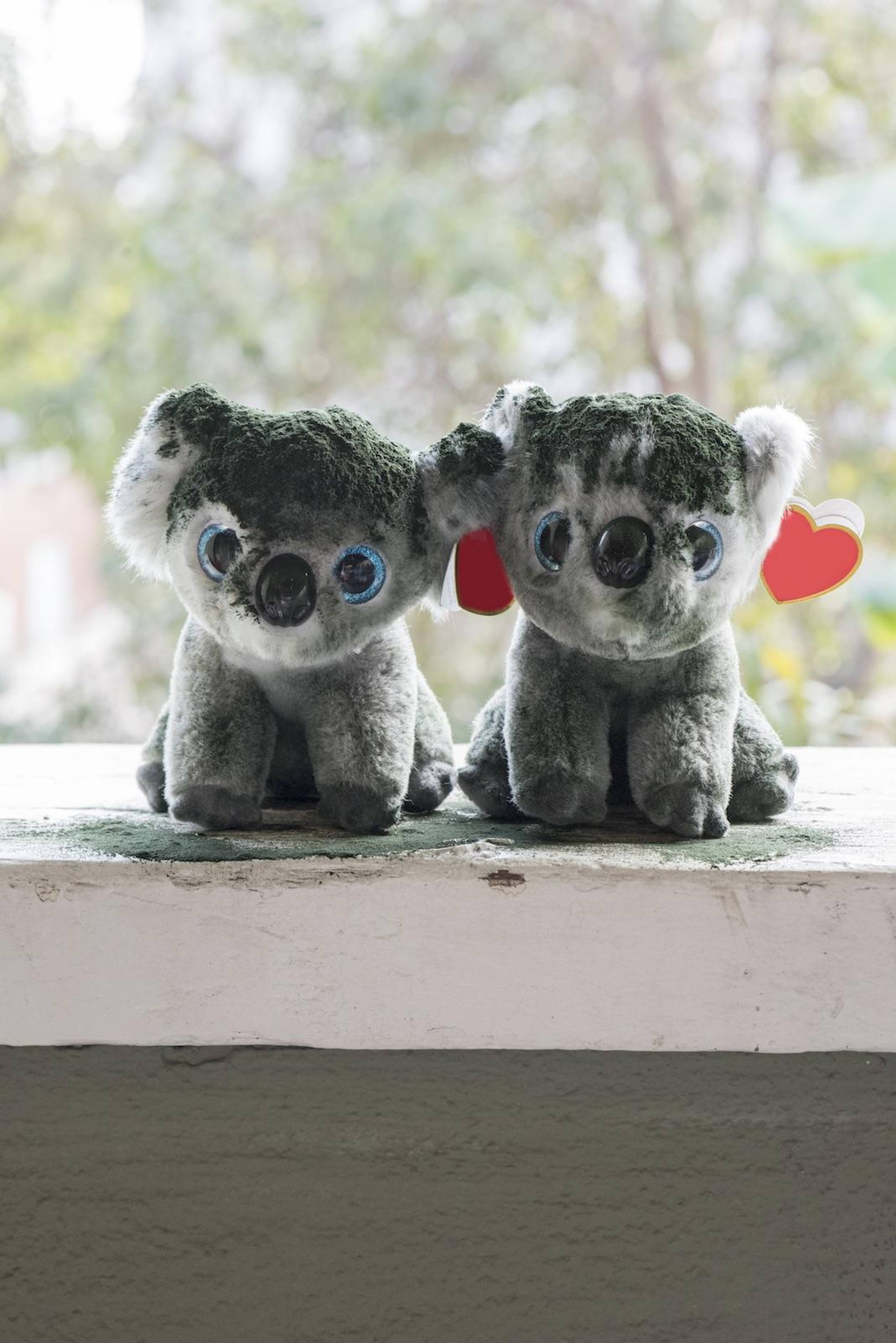Nonfood is the brainchild of Lucy Chinen and Sean Raspet, who, together with Dennis Oliver Schroer and Mariliis Holm, have developed the brand to challenge notions about food, nutrition, flavor, and sustainability, as well as dichotomies between nature and technology by creating “radically sustainable algae-based foods to drastically reduce agriculture's resource and carbon footprint.” Algae has long been a sci-fi dream for replacing fuel and solving world food crises and it is also estimated that marine plants (of which almost all are single-celled, photosynthetic algae) produce between 70 and 80 percent of the oxygen in the atmosphere. Plus, as Chinen put it, “Whenever something is not categorically definitive, it can fit somewhere in the art world.”
Nonfood originated from Raspet’s own art practice, in which he has experimented with the chemistry of taste and fragrance since 2012. After working for Soylent as a flavorist, he wanted to continue producing “artworks that are usable products,” like Bauhaus by way of sci-fi. “making food products with abstract/non-mimetic flavour and using algae as a primary food ingredient.” Chinen’s work as a curator and writer, as well as her media studies at the University of Amsterdam and collaborations with Metahaven, aided the development of Nonfood up until the point where she and Raspet welcomed Schroer, who, along with curatorial knowledge from his project Dingum (that some Berliners may know), has experience with business, brand strategy, and creative direction. They then brought on Mariliis Holm, who has studied algae as a food source and is a food and sensory scientist, having worked at one of the world's largest snacks companies Mondelēz, and Europe’s top agricultural research institut INRA.
Collectively, the collaborators share the belief that concepts born through art can shape everyday life – especially if you push them beyond an art world where “opportunities can be smaller than one would think.” Nonfood is also seen as a space for “experimentation in terms of how the product is presented and advertised,” striving to create a new vernacular for the future of food and the metabolic relationship of eight billion people to the planet’s many ecosystems. Their first product, Nonbar, launched at the end of 2017.
Ché Zara Blomfield: The documentary Cowspiracy [2014] left me pretty convinced that the general sustainability concepts that are widespread – i.e. to stop rainforest depletion due to palm oil, reduce fossil fuel and CO2 emissions, reduce waste, recycle, etc. – fail to grapple with the reality that, statistically, the farming industry far exceeds depletion of resources on all fronts: waste, destruction and emissions, contamination of natural resources. Does Nonfood represent the polar opposite, the cultivation of natural resources? Is it actually aiming to counteract the structure of consumption?
Sean Raspet: Yes, that is Nonfood’s goal and the reason it was founded. There is an urgent need to come up with new ways of living, including new food sources to counteract and provide alternatives to the extremely wasteful current modes of agriculture. Algae is unique because it’s highly efficient at turning sunlight, water, and CO2 into vitamins and nutrients, more so than any other crop.
Differences between organic and conventional farming are fairly small in terms of their environmental footprint.
CZB: Sean, you’ve reasoned for non-organic farming, saying the crop yield is higher, yet these single-crop, monocultures have high risks and would only lose a tiny fraction of their harvest if they didn’t use pesticides that kill pollinators.
SR: Organic farms actually do, or can, use pesticides. It’s a common misconception about organic versus industrial farming. Sometimes, organic farms actually use much higher volumes. The pesticides are generally different, though not necessarily better for the environment. I would encourage people to research the topic. Also, there are plenty of organic monoculture farms and plenty of organic “factory farms.”
The issue of organic versus industrial farming is a complex one, and it’s not clear cut to say that one or the other is better for the environment; it depends on the specifics, on a case-by-case or farm-by-farm basis. I’m not necessarily a proponent of either system over the other. because there is so much variation between farms that it’s impossible to make a generalization. Differences between organic and conventional farming are fairly small in terms of their environmental footprints. It’s more like the difference between two competing brands of the same product.
CZB: So are there more arguments for monoculture or organic farming than just profit?
SR: In the end, it’s a question of scalability for a world with almost eight billion people. One thing organic farming does well is recycling phosphorus and maintaining soil fertility, yet one thing it may not be so good at is producing higher yields, which means higher resource consumption and carbon emissions for the same amount of food.
We think there’s another, much better way: algae. The old distinctions between organic and conventional don’t even apply with algae. Pesticides aren’t needed for something grown in a closed bioreactor system. The use of fertilizer is minimal and is mostly recycled within the system, and the same is true for water use.
Sustainability isn’t sexy. It really usually isn’t the main reason why people are attracted to something.
CZB: It’s interesting when considering consumption, especially of food, that the notion of sustainability itself is unfounded, that presently there are no accessible sustainable solutions. Do you think Nonfood provides an alternative?
Lucy Chinen: Sustainability isn’t sexy. It’s not really why people are attracted to something; usually, sustainability has to be a sidecar to some sort of “quality over quantity” or ascetic doctrine in order to be adopted. When faced with the idea of sustainability itself, I think most people just feel imposed guilt, because modern society is so obviously so wasteful. As with technology, food production happens somewhere else; it’s very hard to feel a relationship to CO2 levels via your Zara purchase. People are also selfish, so in order to be sustainable you have to appeal to a consumer’s self-interest. In the case of food, it’s nutrition. We are trying to make new moves in that area as well because we don’t subscribe to the high-carb food pyramid that is today’s standard. By now, we know that old sugar adverts claiming increased energy was just marketing. There is so much un-doing of food marketing that needs to be done.
I think creating new modes of production and distribution of food is key to mass adoption. I would like the culture of sustainability to be interesting and strange – not hippy or tree-hugger. Nonfood is one way to work through these possibilities.
CZB: In the documentary Beyond Food [2017], a nutritionist claimed multivitamins don’t work because the body can’t process individual vitamins when they are combined. Do you know much about this? How can the nutrition of Nonbar, or even algae, be quantified in consumers?
Mariliis Holm: Many people consume multivitamins just to feel secure that no micro-nutrient is underrepresented in their body at any point of time. However, by eating a balanced diet, it is usually possible to get all the essential vitamins and minerals from daily food sources. Nevertheless, it is true that some vitamin-mineral and mineral-mineral combinations have inhibiting effects on each other. For example, magnesium, copper, iron, and calcium all compete for absorption in the body, and too much of one can lead to low levels of the others in one’s blood.
One of the biggest issues with mineral absorption is in iron deficiency, which has increased as flexitarian, reducetarian, vegetarian, and vegan diets have gained greater social traction. When consumers decrease the amount of animal products in their diet, what can easily happen is that the necessary amount of iron is no longer met. Iron deficiency causes low blood oxygenation, which then causes tiredness and, in extreme cases, premature death. To combat iron deficiency, consumers are advised to take iron supplements or eat spinach. However, spirulina, one of the micro-algaes used in the Nonbar, contains twenty times more iron than spinach. In addition, the iron in spirulina and Nonbar is “bio-available”: the body can absorb it in fully.
To quantify the macro- and micro-nutrients in one’s body, you can either make estimates with various nutritional apps or, for something surer, get your blood tested. Home diagnostics such as Cue are already rolling out for people to measure vitamin D levels on their own.
CZB: What is some of the research, or some of the sci-fi, that inspired Nonfood? I’m recalling ideas of algae as space-travel fuel and a marketing of algaculture as the answer to the globe’s food and energy crises.
LC: Although algae has appeared in a lot of sci-fi worlds, I would say that Nonfood isn’t inspired by fantasy, but historical reality. The way food is produced now will conclude in a future that is structurally dystopic. Looking at that situation straight on creates an interesting design problem. Research into food culture in the past helps us consider the current adoption of ingredients new to the Western world as a cultural challenge.
MH: The US and Soviet space agencies explored algae as a potential food and oxygen resource for space flights in the 60s, while as early as 1974, the World Health Organization declared Spirulina to be the best food for the future. Last year, NASA’s Biology and Mars Experiment announced that algae can survive nearly a year and a half in the extreme conditions of outer space. Meaning, that it definitely has the potential not only to feed the Earth sustainably, but for future Mars missions, too.
LC: So although algae seems futuristic or from a world of fiction, it has been a part of contemporary reality for some time now, both to preserve life on earth or in space.
– “After Art” is a series about people who have left the art world and what can be achieved out there –







